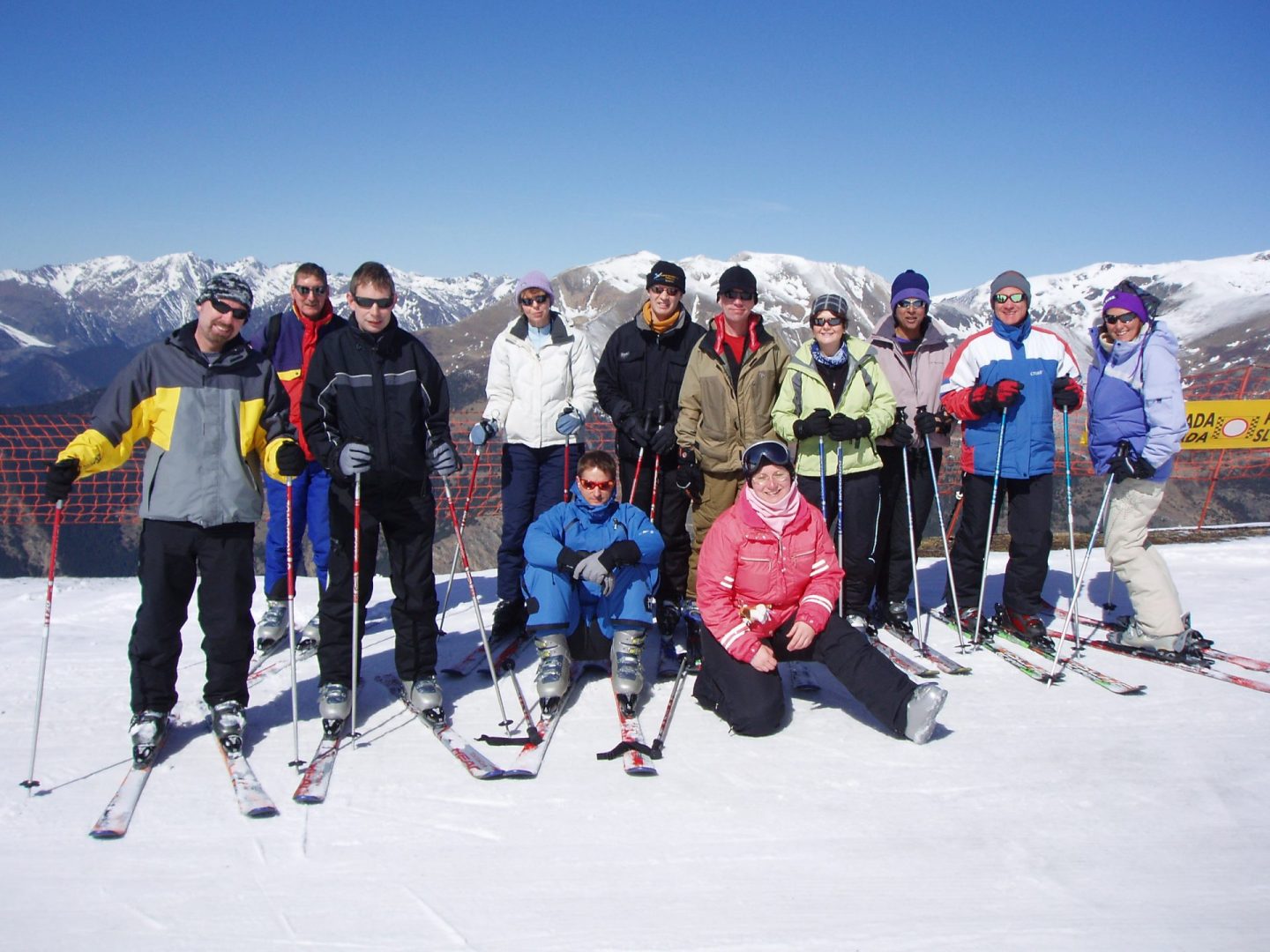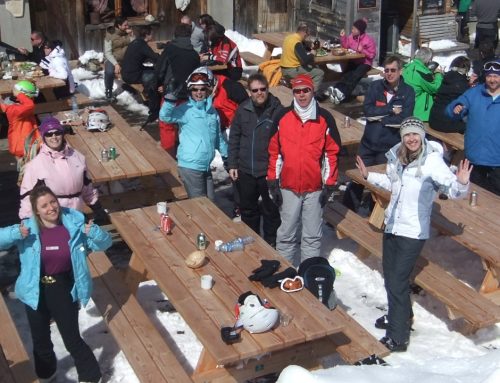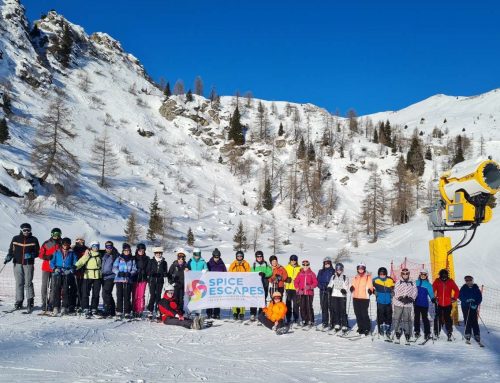Ever felt like you’ve suddenly entered a cartoon world?
I have.
Not so much Bedknobs and Broomsticks as Wile E. Coyote and The Road Runner. Though I wasn’t the slender, feathered speedster but the hapless, hungry coyote. About to get his comeuppance.
It happened during my first ski trip. And all because I’d made a rookie error.
An easy mistake to make. And an easy mistake for a smart cookie like you to avoid.
But one I didn’t realise until I was hurtling down a run like Eddie the Eagle. Only with nowhere to take off. And seemingly no way of stopping.
No way except by ploughing headfirst into a huge mound of snow.
Cue Loony Tunes music. Cue me about to disappear into the mountain, leaving a deep, black outline of a beginner skier with rented skis and rented poles splayed in all directions …
Where did I go wrong?
Find out in a moment. But first, here are 6 Spice-y tips to help you ace your beginners skiing holiday. And make sure you avoid any cartoonesque moments.
1. Where to ski as a beginner
Most ski resorts have nursery slopes. And it’s an excellent idea to spend some time there in ski school learning the ropes.
But after a few days you’ll be looking to graduate to something slightly more challenging. And when you do move on to the next level, you don’t want to be leaping from the nursery straight up to the 6th form.
So, find a resort with plenty of beginner runs.
How? By studying the resort’s piste map online.
Ski runs are colour-coded to help you gauge how easy or difficult it will be to ski down them. In North America and most of Europe, you’re looking for lots of green (beginner) and blue (moderate) runs.
These gentle runs are well-groomed and wider than other runs, making them perfect for learners.
Another tip is to look for a family-friendly resort. If a resort’s known for being good for kids, it’s likely to be perfect for beginners – of whatever age.
2. Where to stay
You’ve chosen your resort. Now let’s book your accommodation.
Broadly, you’ve got three choices:
● Hotel – Many come with heated outdoor and indoor swimming pools, sauna, spa facilities and a gym. Perfect for soothing those tired muscles after a long day’s skiing.
● Catered chalet – Breakfast, afternoon tea and dinner are all taken care of, leaving you to relax and concentrate on perfecting your snowplough. And exercising your après-ski drinking elbow!
● Self-catered apartment – This gives you the flexibility of deciding what time you want to eat. But bear in mind it can get a little pricey if you don’t fancy cooking and end up eating out most nights.
Whichever option you go for, have a look to see where your accommodation is based.
How far is it from the slopes (and bars)?
Is it ski in, ski out? Or will you have to arrange transport each day?
If so, are there good transport links and will you be able to store your equipment in lockers to save you having to cart it around with you?
3. What to wear
If a skier were a food, what would they be?
Ski yogurt? ‘Ski Sundae’? (Best TV theme tune ever.)
No. An onion.
Because with ski clothes, it’s all about layers.
You see, layers trap warm air near your skin.
Base layer
A wicking base layer will keep you dry. But avoid cotton. It absorbs sweat, which will freeze as you climb for your next run. A long-sleeved thermal top is ideal for your top half and yoga leggings or runner’s tights for your legs.
Mid layer
Wear one or more t-shirts, sweatshirts or jumpers, ideally made of wool or fleece material. Remember, lots of thin layers beat one thick, woolly jumper. Every day of the week.
Make sure your jumper is shorter than your ski jacket. Or tuck it in. Otherwise the bottom will get wet and freeze.
Top layer
You need either a ski suit or a ski jacket and ski trousers (salopettes).
Beg. Borrow. Steer clear of making expensive purchases.
And don’t worry about colour-coordinating your clothes. This ain’t no fashion parade. So long as it fits, feels comfortable and keeps you warm and dry, you’re good to go.
Other clothes
You’ll also need:
● Hardwearing, waterproof gloves – and perhaps a pair of thin gloves underneath
● Ski socks (wear one pair but bring two)
● A snood or neck tube (trailing ends from scarves can catch the wind)
● Goggles
So now you know your ski-clothes onions, what else do you need?
4. What to hire on your first ski trip
Hire – don’t buy – your skis, poles and boots. You can usually save quite a bit if you book in advance online.
And pick up your ski equipment as soon as you’ve checked in at the resort. If you leave it till the morning, expect to queue with hordes of others.
Make sure you get fitted out with the right boots from the start.
Some tips from the boot room:
● Cut your toenails.
● Wear one pair of ski socks only.
● Allow plenty of time to get properly fitted.
● Try on as many different pairs as you can until you find your best fit.
● And walk around in them for 15 minutes to see if any problems develop.
You’ll also need a helmet with a snug fit. Make sure you try it on before you hire.
5. What to pack
Some travel essentials:
● Tickets, passport and foreign currency
● Travel insurance with winter sports cover
● GHIC card (or your EHIC card if unexpired)
● Camera
● 2 passport-sized photos for your ski pass – write your name on the back and have them handy for your ski rep on the transfer coach
● High-factor sunscreen
● Fully charged mobile with charger and adaptor plug
● Hat
● Snow boots (if you have them) or sturdy, waterproof shoes/boots for walking round the resort
● Après-ski clothes – most people wear casual clothes, such as jeans, leggings, t-shirts and jumpers.
Whatever you wear, keep your ears open and listen out for the music! A ski trip is not a ski trip – certainly not a Spice Escapes ski trip – without enjoying some live music, dancing and a few drinks at the end of the day.
Also good to have:
● Sunglasses
● A bum bag or rucksack
● Water bottle
● Slippers
● Swimwear
6. How to look after yourself
Finally, take good care of yourself.
Get in shape before you go. If in doubt, see your doctor and get a full medical check-up.
Stretch before you ski and relax your muscles at the end of the day. That spa and sauna are calling you!
Ski in a group or with a ski buddy. Make sure you always carry a piste map. And follow the International Ski Federation’s Rules of Conduct and any applicable local ski rules.
Keep hydrated and apply high-factor sunscreen. Even when it’s cloudy.
And take it easy. Call it a day when you’re feeling tired.
A few final do’s and don’ts for first-time skiers
Do …
● Borrow clothes where you can.
● Protect your skin and eyes from the sun.
● Sign up for ski school.
● Do, do, do wear a helmet!
● And do get involved with the après-ski – where the skiing ends and the party begins. Everyone should dance on a table in their ski boots at least once …
But whatever you do, DON’T …
● Splash out on expensive clothes or equipment.
● Worry about falling over. Everyone does. The snow’s soft and you just get back up again.
● Listen to your experienced friend when they tempt you down a red run with the words ‘you’ll be fine’.
That’s where I went wrong. Although, happily, it turned out my friend was right.
My time spent in ski school was time well spent.
So while in my head I was careering into cartoon land, my feet and knees remembered how to snowplough and brought me to a smooth(ish) stop.
Lesson learned.
Like learning to drive
Going skiing for the first time can seem a little daunting. There’s a lot to think about and a lot of gear to obtain.
But a skiing holiday is also tremendous fun. And it’s a fantastic way to meet people, particularly on a trip like the ones run by Spice Escapes .
You’re guaranteed to make friends. And there will be lots of people in exactly the same boat as you. Embarking together on your first voyage on the good ship Skiing Holidays Rock!
And remember – everyone on the slopes was a beginner skier like you at some point. Many of them after achieving a certain vintage.
There was a time when you couldn’t drive a car or ride a bike. Then you learned how and haven’t looked back since.
Skiing is no different.
What tips for beginner skiers would you add to our list? Let us know in the comments below.




